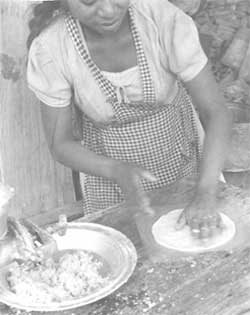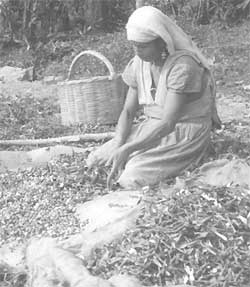 Patting out tortillas; photo 1956, but it's
done exactly the same today
Patting out tortillas; photo 1956, but it's
done exactly the same todayOften Yerba Buena's visitors have contributed stories to the Newsletter detailing their impressions about what goes on at Yerba Buena and the surrounding region. Such was the case in early l965 when Helen Frazee and her husband passed through, and Mrs. Frazee wrote the piece presented below. Before getting to that story maybe a couple of terms need to be explained.
"Chamula" is a word coined by outsiders to refer to all indigenous peoples living in Chiapas' Central Highlands, without regard to the peoples' diverse languages and traditions. Several groups, or tribes, are represented here. Apparently "Chamula" derives from the name of a town near Yerba Buena called Rincon Chamula.
The word "Chamula" is a little like the Spanish word gringo, which you'll also find in this book. Most educated Mexicans consider gringo to be a slightly funny, not-respectful-but-not-really-disrespectful term for people from theU. S., and usually they don't use the word, at least not to our faces. However, most folks in this part of Mexico refer to all anglo-saxon-type people from abroad as gringos, often much to the chagrin of the Germans and French. Like the word "Chamula," then, down here gringo is a generic term used to designate a diverse aggregation of people.
Now for helen Frazee's contribution to the February, 1965 Newsletter:
These Chamula Indians are of special interest to me. There are l75,000 of them. Until recently they had no written language. Years ago about 25 of them in this area accepted the message. Later, one of these, Antonio Diaz, came to work at Yerba Buena. He had a great burden for his people. With the Lord's blessing he has reduced their difficult language to writing, and has translated most of the New Testament and some parts of the Old Testament, many songs, and some articles. Tzotzil is the name of their dialect. Dr. Butler has managed to learn sufficient of this strange clicking language so he can take case histories a little better.

Shelling the beans called botil. Photo from 1956 but it could be today.
Yerba Buena Mission is not content just to sew up these people and treat their dysenteries and other diseases; it has a unique plan for training them in healthful living. The Mission has built eight simple two-room Mexican homes. They call it the Model village. The families for this training are chosen from the most promising Adventist Indians; some of them belong to the Zoque tribe. There are some whole villages who are Adventists.
But even among our people there is a great lack in a knowledge of the simple principles of sanitation and healthful living. One of the first things they are taught is to make an out-house. They also learn that water is cleaner in a stream than in the mud puddle in the street where the pigs wallow. The fireplaces where they cook their food are up off the floor in the model homes, so the animals won't get into the food. And the fireplaces have chimneys. This last sounds strange, but these dear people somehow have never thought of making a way for the smoke to get out of the hut where they do their cooking over a fire on the floor. The smoke gets out the best way it can, and the people get sore eyes. Oh, so much to be taught. Along with these fundamental things, other simple principles of health and child care and Christian experiences are taught them. Then they are ready to return to their villages where they become the teachers.